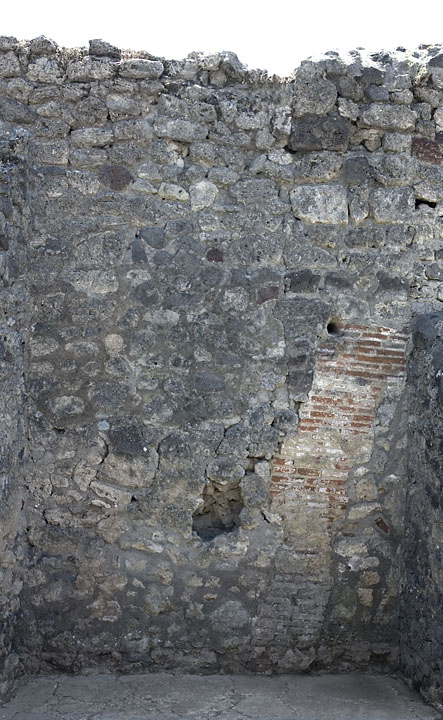South Wall
Description
A. Karivieri & R. Forsell
The wall is located between 24b and V 1,26c.
It has an east-west orientation.
There are some remains of wall-plaster.
The wall has suffered considerable damage, probably due to an earthquake, and has then been repaired. A section of op. testacium is tilting to the west. East of, and above this the repairs have been made in straight lines. No sign of this damage is visible on the other side of the wall in V 1,26 c.
Description: The wall was built in opus incertum except for a later repair in opus testaceum, that is 2.28 m high and 0.33-0.60 m wide. The wall consists mainly of limestone, some cruma and lava, a couple of yellow tuff blocks and some pieces of terracotta. The limestone mostly measures 10-20 cm, but above the opus testaceum repair there are larger rectangular limestone blocks 20x 30 cm. The west end of the south wall is protruding ca 10 cm above the opus testaceum repair where it should have abutted to the upper part of the west wall. In the centre of the lower part of the wall at the height of 0.90m there is a 30x30 cm large hole in the wall where the building stones are missing. Another smaller, round hole is visible beside the upper edge of the opus testaceum repair at the height of 2.20 m, 15 cm high and 10 cm wide. The hole attached to the opus testaceum repair indicates some sort of support.
Wall-plaster:
Wall plaster remains are only visible in some parts of the wall, the largest patch on a limestone block at the height of 1.40 m, 50 cm from the eastern corner. By the floor at least two levels of wall plaster are visible.
State of preservation: The upper part of the wall is missing and there is a large hole in the wall. Some modern repairs have been made.
The preserved floor was made against the plaster covering the opus testaceum repair.
Conclusions: the opus testaceum repair was made before the lavapesta floor was made.
Dimensions: l. 2.46 m; h. 3.90 m.

